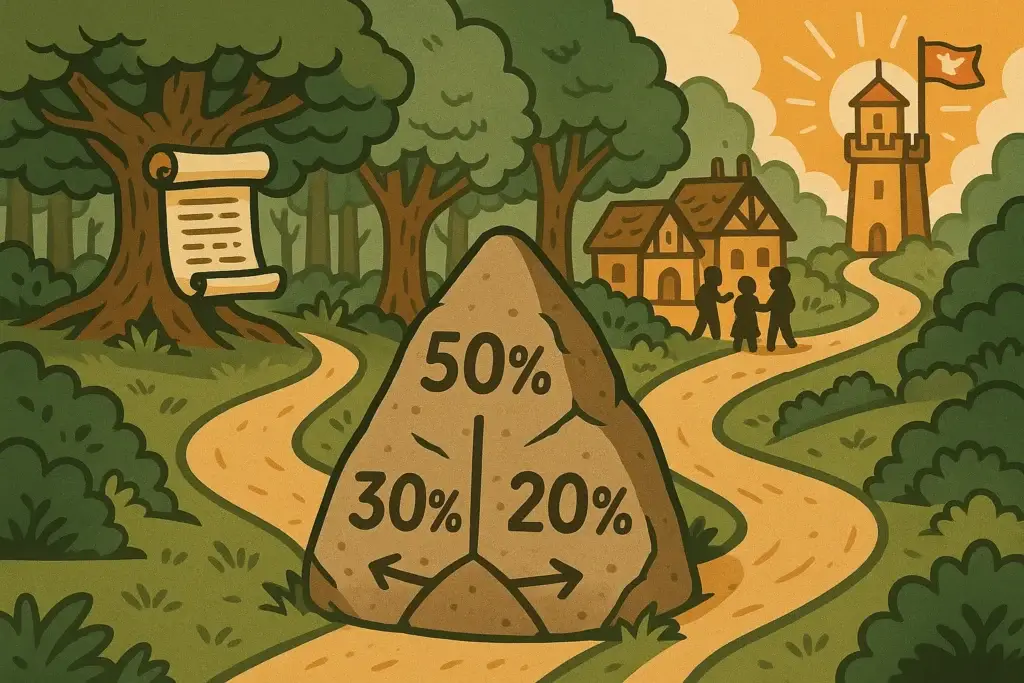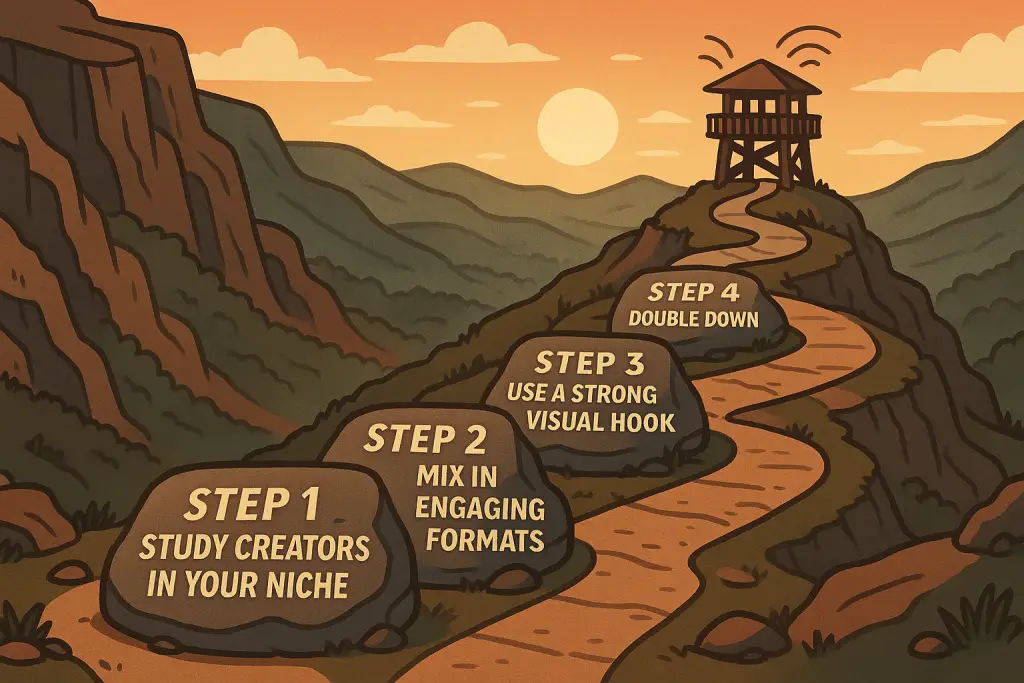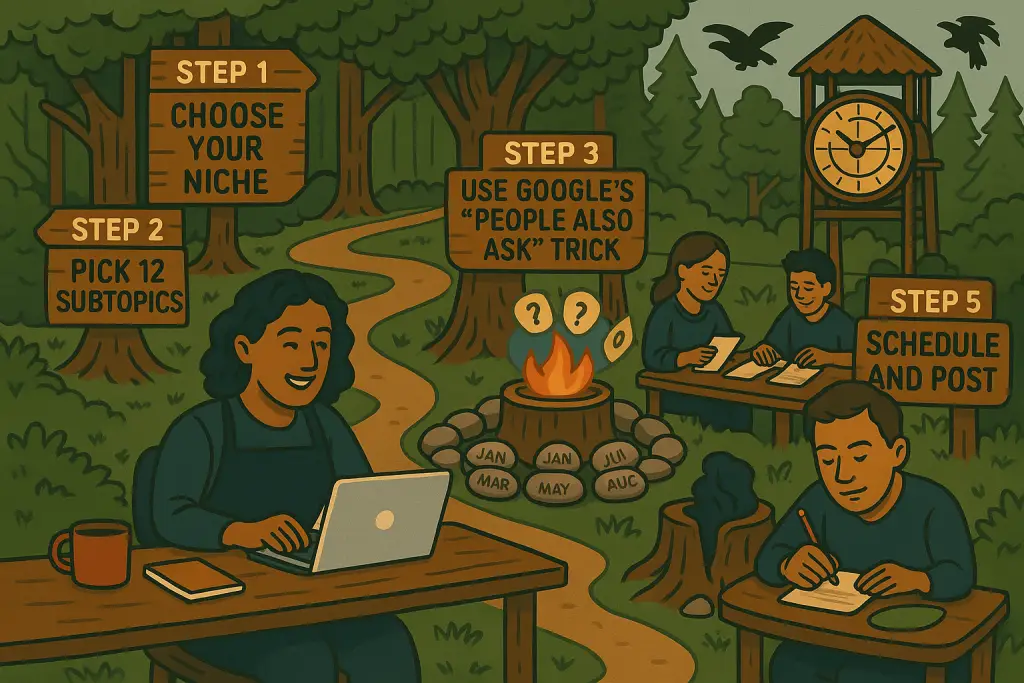TL;DR: Social Media as Marketing – Ultimate Guide for Your Business
Social media as marketing builds trust, loyalty, and visibility by creating authentic connections—not just pushing promotions.
Use content, community, and conversation to turn followers into brand advocates and drive long-term business growth.
Analyze data from posts, comments, and clicks to fine-tune what works and where to adjust your strategy.
Engage consistently, adapt to platform trends, and personalize content to meet audience needs in real time.
Success with social media as marketing requires clear goals, creative storytelling, and steady, purpose-driven execution.
The digital wilderness is no longer a side trail—it’s the main route. And if you’re a business trying to chart your course, social media isn’t just a distraction. It’s your compass.
Done right, social media isn’t noise. It’s your brand’s voice—cutting through the crowd, earning trust, and guiding people to your doorstep.
Whether you’re a solo entrepreneur or running a growing company, this guide will help you treat social media like the powerful marketing tool it is.
Let’s map out the strategies, tools, and mindset you need to build a brand that stands out online—without losing your way.
What Is Social Media as Marketing (SMM)?

When we talk about social media as marketing, we mean using social platforms (Facebook, Instagram, Twitter, LinkedIn, and more) as tools to promote your brand.
Unlike traditional marketing (billboards or TV ads), social media is hands-on and immediate. You can have real-time chats with your followers, adjust your course based on feedback, and actually see who’s listening. It’s a powerful way to create meaningful relationships and grow your business.
Here are your key takeaways:
- Content: social media is a two-way street: connect and engage.
- Community: good content builds trust and loyalty.
- Analytics: they show you what works and what needs to pivot.
- Strategy: Consistency matters more than perfection, set some goals.
Social media marketing is like having a direct line to your audience—it’s personal, fast, and interactive. Instead of one-way ads like billboards or TV, you’re starting real conversations on platforms like Instagram, Facebook, and LinkedIn.
You’re not just promoting—you’re connecting. Great content draws people in, community keeps them engaged, and analytics help you see what’s working so you can adjust your approach.
The key? Show up consistently, set clear goals, and focus on building real relationships. It’s one of the most powerful ways to grow your brand in today’s digital world.
Why Is Social Media as Marketing So Powerful?

In the wild world of online competition, social media is your compass and campfire. It helps you find your way and brings people closer.
Building Brand Awareness and Reputation
Your posts are beacons. They tell the world you exist, what you stand for, and why you matter. Social media has a massive reach; billions of people use social media.
Engaging with Customers and Building Relationships
Trust builds the best relationships. Social media allows you to communicate directly with your audience. You can also gather their feedback. Customers are able to ask questions while you learn what they need.
Driving Traffic and Conversions
Every like, comment, or share is a trail leading back to your website or product page. Staying active on social media lets you find the right audience. It helps you connect with people who are already interested in what you sell.
Leveraging User-Generated Content
Your customers join your journey when they post reviews, share photos, or talk about you online. Encourage participation by offering incentives. You could create a branded hashtag or use influencers to spread the word.
Customer Data
Every interaction gives you golden insights. Customer data shows how people engage with your brand. It helps you understand your audience, their needs, and how to improve your service.
Get our Free Guide – 15 Marketing Mistakes & How to fix them.
Download our free eBook that uncovers 15 common marketing mistakes and how to avoid them.
Why Use Social Media for Your Business Marketing?

In today’s digital playground, social media marketing is key. It connects you with customers and builds brand loyalty.
Plus, it’s crucial for business growth. But remember: it’s not enough to be there; you must stand out.
So, why should social media be a main part of your marketing plan? Let’s explore.
It Boosts Brand Awareness and Engagement
Think of social media as a virtual hangout where new customers gather. Billions use Facebook, Instagram, LinkedIn, and TikTok daily. This gives you a chance to showcase your brand and create connections.
Posting often, sharing engaging content, and having real conversations can boost your visibility. It keeps your brand fresh in people’s minds.
It Builds Trust and Authenticity
Customers trust brands that feel real and relatable. Use social media to build relationships, not just to sell. Share behind-the-scenes moments and customer stories. Respond to comments with sincerity. This builds trust better than any ad.
It Helps You Measure Performance
One great thing about social media marketing is tracking your progress in real time. You can see how many people engaged with your content, its reach, and even how many sales it drove. This data lets you adjust your strategy as needed.
It Drives Sales
A strong social media strategy can lead to real business results. It helps you attract new customers, nurture leads, and increase repeat sales. By turning casual followers into loyal customers, you can create a community of brand ambassadors who spread the word.
Benefits of Social Media as Marketing for Your Business Needs

Benefits of Social Media as Marketing for Your Business Needs
Appeal to Social-Savvy Customers
Today’s customers spend hours every day scrolling, searching, and sharing online. Meeting them where they are with real, valuable content quickly builds strong connections. Your brand becomes part of their daily rhythm, not an interruption.
Uncover Industry Trends in Real-Time
Social media is like an ever-flowing river of new ideas. By following conversations, hashtags, and trending topics, you can see changes in your industry as they happen. It’s like finding hidden trails that lead to new opportunities before your competitors even realize they exist.
Get Comprehensive Competitive Analysis
You’re not trekking through the business landscape alone. Your competitors are out there, too—and social media gives you a front-row seat to watch what’s working (and what’s not). A smart look at your competition’s successes, failures, and audience reactions helps sharpen your own strategy.
Provide Better Customer Service
When customers reach out through social channels, they expect quick, human responses. Fast, thoughtful replies show you’re paying attention—and that you care. Good social customer service can change a small complaint into loyalty. It can also turn an inquiry into a lasting customer relationship.
Extend Brand Reach and Engagement
Every share, comment, and mention pushes your brand further into the world. With smart targeting and engaging content, social media marketing can expand your reach. It goes beyond what traditional ads can offer. This helps you create an active and passionate community.
Gain More Top-of-Funnel Leads
Social media doesn’t just drive awareness—it fills your funnel. With the right mix of inspiring posts, value-driven content, and subtle calls to action, you can draw in new prospects who are ready to learn more, connect deeper, and eventually buy.
Take Advantage of SEO to Supercharge Your Brand
Social signals matter. When people interact with your brand online, it boosts your authority. This applies to both customers and search engines. Sharing blog posts, product pages, and helpful resources through social media helps boost your SEO efforts and increases your discoverability.
Extend Your Media and Investor Relations Efforts
Social media isn’t just for marketing and sales. It’s also a strong tool for building your reputation. Sharing company news, milestones, awards, and leadership updates keeps investors, media, and partners in the loop. It positions your brand as a leader worth watching—and investing in.
When you combine creativity with strategy, authenticity with analytics, and passion with consistency. Your brand won’t only survive; it will thrive.
Why Using Social Media as Marketing Works

At its heart, social media as marketing is about creating a genuine exchange.
Brands add value by teaching, entertaining, or inspiring people. In return, audiences give attention, loyalty, and purchases.
Content, engagement, paid ads, influencer collaborations, and data analysis are all threads weaving your strategy together.
Advantages and Disadvantages of Social Media as Marketing
Advantages
- Inexpensive entry point
- Massive reach potential
- Highly targeted ads and messaging
- Real-time customer feedback
- Builds community and brand loyalty
Disadvantages
- Time-intensive without proper planning
- Reputation risks if handled poorly
- Algorithm changes can shift visibility overnight
- Can become “pay to play” without strong organic presence
11 Strategies for Effective Social Media as Marketing

Social media marketing isn’t just about selling. It’s a stage for storytelling that builds connections, encourages empathy, and provides ongoing value.
When you listen to your audience’s needs, trust builds, and real connections thrive.
This section reveals eight powerful strategies. They focus on storytelling and put your customers first. These tips will boost your social media marketing.
Share Stories and Value, Showing You Care
When using social media as marketing, many businesses focus only on selling. But that’s not the best way to grow. People don’t want ads—they want connection. That’s how you build trust.
Start by giving value. In Jab, Jab, Right Hook, Gary Vaynerchuk explains that you need to help first—then sell. Share tips, funny posts, or inspiring stories. These are your jabs. After people trust you, that’s when you offer a product or service—the right hook.
Next, think about your story. In The Fortune Cookie Principle, Bernadette Jiwa says your product is like the cookie—it’s useful. But the story you tell is like the fortune inside. It makes people care. Share stories about why your business started, who you help, or what problems you solve.
Jiwa also reminds us in Marketing Is a Love Story that marketing should come from a place of care. When you understand your customer’s struggles and show that you’re here to help, people are more likely to support you.
Donald Miller’s Building a StoryBrand gives one more key idea: your customer is the hero—not your brand. Your role is to be their guide. On social media, show that you understand their problems, offer a plan, and help them reach success.
When you use social media as marketing with stories, empathy, and value first, you turn followers into loyal customers.

The 5 C’s of Social Media Marketing
Successful social media marketing is built on five essential pillars: Community, Conversation, Content, Collaboration, and Consistency.
- Community: Cultivate a loyal audience by creating spaces where individuals feel valued and connected.
- Conversation: Engage in two-way communication, showing that your brand is approachable and attentive.
- Content: Deliver high-quality, relevant content that educates, entertains, or inspires, aligning with your brand’s values.
- Collaboration: Partner with influencers, brands, or your audience to amplify reach and credibility.
- Consistency: Maintain a regular posting schedule and a unified brand voice to build trust and recognition.
By integrating these five elements, your social media strategy can foster trust, engagement, and long-term loyalty, delivering results that resonate with your audience.

Adapt to Platform Culture
Each social media platform has its unique norms, tone, and trends. Understanding and adapting to these cultural nuances is crucial for authentic and effective engagement.
- Instagram: Leverage storytelling and visuals to captivate audiences.
- LinkedIn: Share professional insights and thought leadership to connect with a business-oriented audience.
- TikTok: Embrace humor and current trends to engage younger demographics. LC Sign is a great example.
Aligning your approach with each platform’s unique characteristics ensures your content resonates with the right audience at the right time.

The 4 Pillars of Social Media Marketing
A successful social media strategy is built upon four foundational pillars: Plan, Personalize, Participate, and Promote.
These elements work in harmony to ensure your efforts resonate with your audience, foster meaningful relationships, and deliver measurable results.
1. Plan: Setting the Foundation
Every effective social media campaign begins with a solid plan. Without clear direction, your content and engagement efforts may become scattered and ineffective.
- Define Clear Goals: Determine whether your objectives are to build brand awareness, drive website traffic, or generate leads.
- Know Your Audience: Understand who your target audience is, which platforms they frequent, and the challenges they face.
- Create Content Pillars: Organize your content into key themes—such as educational, promotional, and entertaining—to maintain consistency.
- Schedule Strategically: Utilize a content calendar to post regularly and align your efforts with industry trends or seasonal opportunities.
A well-structured plan sets the stage for a cohesive and effective social media presence.
2. Personalize: Making It Relevant
In a crowded digital landscape, personalization is crucial to stand out. Craft messages that feel tailored to your audience’s needs and values.
- Understand Pain Points: Address specific challenges your audience faces with empathy and actionable solutions.
- Leverage Data: Use analytics to identify audience behavior and interests, then craft content that resonates.
- Adapt to Platforms: Tailor your tone and format to fit each platform—for instance, professional insights on LinkedIn or light-hearted humor on TikTok.
Personalization fosters deeper connections and enhances audience engagement.
3. Participate: Building Connections
Social media is not just a broadcasting tool; it’s a platform for engagement. Active participation builds trust and transforms casual followers into loyal advocates.
- Engage Proactively: Respond to comments, messages, and mentions in a timely and authentic manner.
- Join the Conversation: Participate in trending topics or industry discussions that align with your brand.
- Encourage Interaction: Host Q&A sessions, polls, or live videos to deepen your connection with your audience.
By actively engaging, you demonstrate that your brand values its community, fostering loyalty and trust.
4. Promote: Amplifying Your Reach
Even the most compelling content needs visibility. Promotion ensures your message reaches the right audience.
- Optimize Posts: Use relevant hashtags, high-quality visuals, and compelling captions to attract organic engagement.
- Invest in Ads: Run targeted advertising campaigns to expand your reach and drive conversions.
- Collaborate: Partner with influencers or complementary brands to tap into new audiences and enhance credibility.
Strategic promotion amplifies your content’s impact, ensuring it reaches and resonates with your intended audience.
Making Social Media as Marketing Work
Social media marketing is effective when all parts align. Your plan shows how to personalize content. Joining online conversations boosts engagement. Promoting your brand expands your reach.
When these elements fit together, your strategy connects with your audience and produces real results.

The 50/30/20 Rule for Social Media
The 50/30/20 rule provides a balanced framework for content distribution on social media:
- 50%: Sharing valuable, educational content that benefits your audience.
- 30%: Engaging with content from others, fostering community and relationships.
- 20%: Promoting your brand or products in a direct manner.
This balanced approach keeps your audience interested and engaged, ensuring your content strategy is both informative and promotional.

The 5-5-5 Rule on Social Media
The 5-5-5 rule is a daily engagement strategy to boost your social media presence:
- Comment on 5 posts: Engage with others to increase visibility.
- Share 5 pieces of content: Provide value by sharing relevant information.
- Create 5 new posts: Maintain a consistent and active presence.
Implementing this rule helps in consistently growing your social media engagement and presence.

Creating Sticky Content in Social Media Marketing
Sticky content refers to posts that capture attention and remain memorable, encouraging users to engage and share.
Key Elements:
- Strong visuals
- Clear messaging
- Relatable hooks
By crafting content that resonates and encourages interaction, you enhance brand recall and foster deeper connections with your audience.

Leverage Viral Marketing
Viral marketing involves creating content that is so compelling that it is shared extensively, increasing brand awareness exponentially.
Strategies:
- Develop emotionally resonant content.
- Encourage user participation and sharing.
- Utilize current trends to enhance relevance.
While virality can’t be guaranteed, creating content with viral potential can significantly amplify your reach and impact.

The 4-Step Formula to Making Viral Videos
Going viral isn’t random—it’s a skill. The top video creators on TikTok, Instagram, and YouTube follow a smart formula to grab attention and keep people watching. If you want to build a real audience, you don’t need to copy trends—you need to study what works and make it your own.
Here’s a simple 4-step plan that can help you create better, more shareable videos.
Step 1: Study Creators in Your Niche
Before you hit record, you need to learn from the best. Start by finding 3–5 creators in your niche who have seen strong growth in the past year.
Look at their top 30 posts and take notes. Watch closely for three things:
- The hook – What grabs your attention in the first few seconds?
- The format – How is the video filmed? Are they using props, voiceovers, or jump cuts?
- The script or message – How do they speak? Is it casual, fast, funny, or dramatic?
You don’t need to copy them—but seeing patterns will give you great ideas to build on.
Step 2: Use a Strong Visual Hook
Now that you’ve seen what works, it’s time to try your own visual hook. This is something that makes someone stop scrolling. It should happen in the first second.
Here is a whole library to explore and get inspired on TickTock.
Step 3: Mix in Engaging Formats
Next, keep people watching. Viral videos often use multiple styles to stay interesting.
Check out Personal Brand Launch’s video to see great examples to try in your next video.
Step 4: Double Down on What Works
Now it’s time to review and repeat. Top creators don’t just guess—they test.
Look at your best-performing videos and ask:
- What kind of hook did I use?
- Which format got the most views?
- Did people comment or share more on a certain topic?
Take the winning pieces and build your next video around them. You don’t need a brand-new idea every time. Repeating what works is how you grow faster—and keep your audience happy.
You Don’t Need to Go Viral Overnight
The biggest creators didn’t blow up by luck. They showed up, learned what worked, and kept going. You can do the same.
Start by researching your niche, then build smart videos with strong hooks and formats. Study what performs best—and do more of it.
Each video is a lesson. The more you post, the better you’ll get. Stay curious, be consistent, and your audience will grow.

How to Create a Year’s Worth of Social Media Content in One Week
Struggling to stay consistent on social media? Here’s a secret: You can build a full year’s worth of content in just a week—with a smart system. This method helps you avoid burnout, stay organized, and always know what to post.
Ready to stop guessing and start creating?
Follow these steps:
Start by picking one clear topic or niche. This should match what your brand or business is all about.
Examples:
- A fitness coach might choose “Home Workouts”
- A hair salon might pick “Haircare Tips for Busy People”
- A restaurant might choose “Quick Recipes with Local Ingredients”
Choose something you’re passionate about—and that your audience cares about too.
Step 2: Pick 12 Subtopics
Next, break your main niche into 12 smaller themes—one for each month.
Example for “Home Workouts”:
- Bodyweight workouts
- Stretching & mobility
- Quick 10-minute workouts
- Core strength
- Leg day
- Cardio at home
- Dumbbell workouts
- Workout myths
- Fitness gear reviews
- Recovery and rest days
- Mental health and exercise
- Workout challenges
Write these in a spreadsheet or notes app—you’ll build content around each one.

Step 3: Use Google’s “People Also Ask” Trick
Now here’s the gold mine: Use Google to find the most common questions people ask.
Here’s how:
- Google search your first subtopic.
- Scroll to the “People also ask” section.
- Click on a question.
- Google will keep adding more.
- Click 30 times. This gives you around 30 real, popular questions.
Paste those into your spreadsheet under that subtopic.
Repeat for all 12 subtopics.
At the end, you’ll have around 360 highly searched questions—all topics your audience is already curious about.
Step 4: Turn Questions Into Content
Each question is a video idea, a caption, a blog post, or a carousel. Use the questions to:
- Film short videos answering one question at a time.
- Turn the best answers into Instagram Reels, TikToks, or YouTube Shorts.
- Turn top-performing videos into longer how-to or tutorial posts.
You can batch film and edit one subtopic at a time. That’s one month of content done in a few focused sessions.
Step 5: Schedule and Post
Once filmed, use a scheduling tool (like Later, Buffer, or Meta’s Creator Studio) to plan your posts ahead of time.
Try posting:
- 1–3 short-form videos per week
- 1 story or behind-the-scenes post per week
- 1 tip, quote, or photo post weekly
That’s over 150 posts from your list—with more ready if you want to do daily content.
Make Content Creation Easy and Repeatable
When you build content around what your audience is already searching for, you’re never stuck for ideas. This method helps you work smarter—not harder. And the best part? Once you’ve done it once, you can repeat it every year with new subtopics or updated questions.

Harnessing Earned Media in Social Media Marketing
Earned media encompasses the organic exposure your brand gains through word-of-mouth, reviews, and user-generated content.
Components:
- Product reviews
- User-generated content
- Customer testimonials
- Social media mentions and shares
Earned media builds trust and credibility, as it reflects genuine customer experiences and endorsements, often proving more persuasive than traditional advertising.
By implementing these strategies, you can effectively utilize social media as a powerful marketing tool, fostering meaningful connections and driving sustained growth for your business.
By implementing these strategies, you can effectively utilize social media as a powerful marketing tool, fostering meaningful connections and driving sustained growth for your business.
How to Create a Strategy to use Social Media as Marketing

To crush it using social media as marketing, you must have a strategy. It should align with your business goals and resonate with your target audience.
Understand what makes each platform unique. Set clear goals and create content that resonates. When you do this, you’ll build connections that lead to real results.
Step 1: Set Goals and Establish Key Performance Indicators
You wouldn’t head out on a big trip without a plan, and the same goes for social media. A solid strategy is your roadmap—without it, you might end up lost or wasting time. Here’s how to make sure you’re on the right path:
Define Your Goals (with examples):
What are you trying to achieve? Each goal shapes how you move forward.
- More traffic to your website
- Bigger brand awareness
- More sales
Focus Areas Based on Goals:
- For sales: Focus your content on product highlights and use clear calls to action.
- For brand awareness: Share stories that engage and spread your name.
Set clear, measurable goals, such as:
- Gain 1,000 Instagram followers in six months.
- Increase website traffic by 50%
- Boost engagement rate to 5% on Facebook.
This way, you know exactly what success looks like.
Know Your Audience:
Who are you talking to? Define your ideal customer like you would choose your travel companions. Are they tech-savvy teens on TikTok, busy parents on Facebook, or professionals on LinkedIn?
Knowing who you’re speaking to helps you create the right content. Think about their age, job, interests, and what kind of content they enjoy. This way, you’ll know exactly what stories to tell to keep them engaged.
Study the Competition and Trends:
Take a look at what others are doing. What types of posts are getting the most attention? Are there any new trends you should be aware of, like live videos or short-form content? Staying aware of the competition and trends helps you avoid mistakes. It also lets you spot opportunities before they slip away.
Create a Content Calendar:
Think ahead about the stories you want to share and when. A content calendar helps you stay organized and keep you on the right track.
Mix your posts with:
- Product highlights
- Helpful tips
- Behind-the-scenes glimpses
- Special offers
Make sure to schedule them on a regular basis. Consistency is key—posting even a few times a week can keep your audience engaged if it’s planned out well. Having a schedule also prevents you from scrambling at the last minute when things get busy.
Need help getting started?
Try using HubSpot’s free Social Media Content Calendar Template. It’s an easy-to-use spreadsheet that helps you organize your posts by date, platform, format, and topic—all in one place.
With a strong calendar and smart planning, you’ll never wonder what to post again.
Prepare Your Profiles (Branding):
Make sure your social media profiles are consistent and clear.
TIP: Use the same logo, color scheme, and voice across all platforms so people can easily recognize your brand.
Have a clear bio and contact info, too, so followers know how to reach you. This makes your brand feel professional and trustworthy.
By following these steps, you’ll feel confident and clear when using social media. With a solid plan in hand, you’ll know exactly where you’re going and how to get there without wasting time or energy.
Step 2: Research Your Target Audience and Select Your Networks
Know who you’re speaking to and where they hang out, not every trail is right for every traveller.
X/Twitter
A rugged, fast-moving ridge with quick updates. Good for tech-savvy audiences, news, and timely conversations. It’s great for sharing short announcements, participating in trending topics, and building quick interactions.
If your brand is news-driven or opinionated (like a guide announcing a weather change), Twitter can be your lookout tower to shout updates.
These are popular mountain paths bustling with travelers of all ages. They’re great for both B2C (business-to-customer) and community building. Instagram is strong on visuals and short videos, while Facebook is versatile with posts, groups, and events.
Use these if your audience is broad. For example, lifestyle and retail brands often shine here. Instagram Reels are like campfire tales that can quickly go viral beyond your usual group.
This is the seasoned professional mountain pass. Ideal for B2B marketing, tech, finance, and consulting. It’s quieter and more formal, great for sharing long-form articles, industry news, and connecting with peers.
If your business relies on professional networking or has a strong business story (like climbing a corporate summit), plant your flag here.
A peaceful meadow filled with inspiration boards. Excellent for lifestyle, fashion, home decor, and anything visually appealing.
Think of each pin as a trail marker on a community mood board – when users plan something (like a wedding or recipe), your product can appear as a source of inspiration.
TikTok
A high-energy platform with mostly young explorers who love video. TikTok is like a rapid river rafting through the forest – short, fun clips, trends, and challenges. It’s great for showing personality and creativity in brief bursts.
YouTube
Great for posting longer videos, tutorials, and storytelling. If you can craft helpful how-tos or entertaining stories, these platforms let you lead a growing pack of curious hikers.
Picking Networks for Your Marketing Strategy
Don’t spread yourself too thin, initially pick 1-2 platforms that align with your business goals. Identify your target audience and research which platforms they use the most; and you can always expand your platform later.
By focusing your efforts, you won’t get lost trying to explore too many trails at once.
Step 3: Create (and Curate) Timely & Engaging Social Content
Creating content for social media is like telling stories around a campfire—your job is to keep everyone engaged and coming back for more. Here are some tips to help you do just that:
Defining Your Content Strategy
Before you dive into posting, you need a smart plan. Think about what kind of trail you want your audience to follow. Social media is a wild, busy forest—and strong visuals are your trail markers.
Post high-quality photos and videos that show your product in action, share behind-the-scenes moments, or reflect the spirit of your brand. Keep your colors and style consistent—like flying your own recognizable flag.
💡 Need help with content planning?
Be sure to revisit our sections above on How to Create a Year’s Worth of Social Media Content in One Week and The 4-Step Formula to Making Viral Videos for easy-to-follow strategies that make content creation fast and effective.
Share Helpful and Interesting Content
Offer useful tips, how-to guides, or quick advice tied to your business. If you sell camping gear, teach people how to pack for a weekend trip. If you’re a financial advisor, share easy money-saving hacks. This kind of content is like trail supplies—people keep coming back for more.
It’s also okay to invite people to take action, like visiting your site or signing up for a newsletter. Just don’t push too hard. Say it in a friendly way: “Want more hiking tips? Check our blog!” or “Swipe up to grab your gear.”
Find Your Brand Voice
Your brand should sound like a real person—not a sales robot. Talk the way you would in a friendly conversation.
Match your visuals with simple, honest captions. Stay upbeat, avoid business buzzwords, and share stories or small tips. Instead of saying, “Our new mattress features enhanced ergonomics,” say, “Tired after a long day? Our new mattress feels like sinking into a cloud.”
Bake Timeliness Into Your Strategy
You don’t always need brand-new content. But you should make key info easy to find.
Use tools like Instagram Highlights or Facebook Guides to save your best tips, FAQs, or advice. Think of it like leaving clear trail signs—people can always find their way back to your most helpful content.
Take Advantage of Short-Form Video
Short videos grab attention fast. They give people a quick, fun way to connect with your brand.
Post product demos, updates, or live Q&A sessions. TikTok, Instagram Reels, and Facebook Live make it easy to share quick moments that feel real and fresh. A short video showing how to pack smarter or use your product can go a long way.
Show Off Your Human Side
People connect with people—not logos. Let your customers and team help you tell your story.
Encourage your customers to share their own photos, videos, or stories using your product. Reposting this kind of content (called user-generated content or UGC) builds trust and makes your brand feel more relatable.
Mix up your content: friendly photos one day, a how-to video the next, then maybe a behind-the-scenes shot or funny meme. This keeps your campfire circle lively—and your followers coming back for more.
Step 4: Collaborate With Influencers
Influencers are like friends who introduce you to new people. They broaden your brand’s reach by connecting you with their engaged audience. Their endorsement builds trust and familiarity with potential customers.
Strong influencer partnerships can:
- Boost traffic
- Create great content
- Inspire real purchases
Today’s audiences are smart. They seek creators who:
- Genuinely believe in what they’re promoting
- Feel authentic
Trust is important, but follower count, consistency, and community loyalty weigh just as much. So, how do you stand out?
Pick creators who:
- Tell real stories
- Rally loyal followers
- Move people to action
Step 5: Bring Other Departments Into the Mix
Which Departments Can Benefit from Social Data?
When it comes to social media as marketing, you’re not just posting content—you’re tuning into the real voices of your customers. These insights can shape way more than marketing campaigns. They can transform your business.
Brands that share social insights across departments aren’t just surviving the landscape—they’re leading the way. Here’s how different teams can benefit from social data and why it’s time to think bigger.
Human Resources
Social media isn’t just for selling—it’s for hiring, too.
Partnering with HR to create social-first employer brand strategies can help attract stronger, more qualified candidates. Creative hiring posts on LinkedIn or employee spotlights show off your company culture and make your brand more appealing.
If you see social media as marketing and recruiting combined, you’ll build a team that’s just as strong as your brand.
Sales
Sales teams thrive on insights—and social data can give them exactly that.
Tracking conversations and trends from social channels helps sales reps better understand what customers want and when they’re ready to buy. Sharing this information equips them to close more deals in a world where online conversations drive real decisions.
And if you want an even bigger advantage, dig into social selling—building authentic relationships online that lead naturally to sales.
Product and Merchandising
Your customers are telling you what they want—are you listening?
Social inboxes are full of product ideas, feedback, and feature requests. Instead of letting those comments float by, smart brands turn them into action plans.
Using social data alongside traditional research helps product teams create offerings that truly match customer needs. That’s how you build products people are already excited for.
Customer Care
Customer care isn’t just about solving problems—it’s about building loyalty.
Tracking metrics like reply time and response volume helps you spot what’s working and where you can improve. Strong social customer care makes customers feel heard and valued, turning a good experience into a lasting relationship.
When you treat social media as marketing and service, you strengthen the heartbeat of your brand.
Overall, Social media as marketing is bigger than content and clicks. It’s a source of insights that can fuel HR, Sales, Product Development, and Customer Care.
The brands that listen, share, and act on social data aren’t just wandering—they’re charting new paths. Social isn’t just the mountaintop view. It’s the trail that gets you there.
Step 6: Evaluate and Improve Your Social Media Strategy
When it comes to social media as marketing, setting a strong plan is just the start—you have to stay ready to pivot.
Success is watching what’s effective. It’s about catching slowdowns early and making fast adjustments. This way, you avoid larger problems later. Social media combines strategy with quick reactions. It’s like altering your course when the trail suddenly changes.
Brands that treat social media as marketing with a watchful eye aren’t just hoping for results. They’re making them happen—and they’re getting there faster.
11 Strategies for Long-Term Results using Social Media as Marketing

Your social media marketing strategy isn’t something you set once and forget.
Like any great adventure, you need to check the map, adjust your gear, and stay alert to changes in the terrain.
Here are 11 focus areas to keep your approach strong and adaptable:
1. Secure Executive Buy-in and Engagement
Leadership support makes a huge difference.
- Show the return of investment (ROI) using social listening.
- Provide pre-written posts.
- Position execs as thought leaders.
Encourage authentic engagement and support employee advocacy. This will strengthen your brand from the top down.
2. Ensure You’re Not Deviating from Your Set Goals and KPIs
Every journey needs a clear destination. Success can mean different things. It could be brand awareness, engagement, or generating leads. Align your metrics (reach, CTR, engagement) with these goals and stick to them like a compass in the field.
3. Build on Your Influencer Marketing Efforts
Influencers can be great trail guides. Their content helps lead new audiences to your brand. Use a platform to manage influencer campaigns, track ROI, and connect those efforts to revenue. It’s one of the most effective ways to boost your social media marketing impact.
4. Take Advantage of AI and Automation
Let AI handle the heavy lifting—from content creation to sentiment analysis. Chatbots, automated reports, and smart recommendations help you work faster. They also support better decisions with real-time data.
5. Use In-Depth Reporting to Prove Social ROI
Good reporting shows why social media as marketing matters. Monitor key numbers such as leads, clicks, and engagement. Share quick, clear reports that show how your work helps the whole business grow. When you make it easy to see the results, it is easier to get support for future plans.
6. Focus on Audience Segmentation and Tracking
Use platform data and AI tools to target specific groups. Focus on behavior, demographics, or sentiment. Better targeting leads to more relevant content, improved ROI, and stronger audience alignment.
7. Optimize Your Content Strategy
Great content is like a well-marked trail—it keeps people moving forward. Share user stories, customer photos, and content that feels personal. Use AI to break creative blocks and build a mix of formats—videos, graphics, and carousels. Stay consistent with your brand voice and post with purpose.
8. Champion Workflow Efficiencies to Empower Your Team
Managing social media marketing can quickly become overwhelming. Use smart tools and better systems. They save time, reduce mistakes, and help your team focus on what matters: creating great content and building real connections.
9. Prioritize Social Customer Care
When people reach out, they want a real response—not an echo in the canyon. Use tools to deliver fast, helpful, human replies. Personalized support builds loyalty and reminds customers there’s a real person behind the screen.
10. Engage and Build Community
Community is your basecamp. It’s where people gather, share, and connect. Show up in the comments, spark conversations, and collaborate with loyal fans. Use interactive content like polls or challenges to keep your circle active and growing. A strong community is one of your best assets.
11. Analyze and Iterate Your Efforts
No trail stays the same forever. Keep testing your content, tracking performance, and adjusting based on what works. Track which content gets the best results and use those insights to shape future campaigns.
Use clear data to guide your choices, refine your route, and build smarter campaigns. Set up clear benchmarks and stay flexible when platform algorithms change. The more you learn, the further you go.
Conclusion: Make Social Media Work for You
Social media as marketing isn’t just another task—it’s one of the best ways to connect, grow, and build something real. It takes strategy, creativity, and consistency to get it right. Yet, every post, comment, and share brings you closer to your goals.
The most successful brands are the ones that listen, stay flexible, and keep showing up. Whether you’re sharing helpful content, responding to customers, or testing new ideas, it all adds up.
Use what you’ve learned here to keep your plan focused, your message clear, and your team moving in the right direction. With the right mindset and steady effort, your brand can stand out and grow stronger every day.
Additional Resources
- The Marketing Dispatch – Find more articles, providing simple strategies, quick field guides, and fresh ideas to keep you informed and on the right trail.
- Social Media Examiner – Tips, news, and best practices.
- Hootsuite Academy – Free and paid courses.
- HubSpot – Industry-recognized training and AI tools.
- Neil Patel’s Social Media Blog – SEO and SMM expert insights.
How EV Agency Helps Small Businesses Compete on Social Media

In a world where big brands take over your feeds with slick ads and deep pockets, it’s easy to feel like your business is shouting into thin air.
With the right plan, even small businesses can compete with the giants. They can build a loyal following and succeed beyond their size.
At EV Agency, we specialize in helping smaller businesses make a real impact on social media. We’re not about throwing random posts at a wall and hoping something sticks. We create custom plans that sound like you, connect with your audience, and grow your brand on purpose.
Need help creating engaging content, launching targeted campaigns, or analyzing performance? Our social media services can boost your growth while keeping costs low and stress levels down.
Our focus is on:
Telling stories that build connections
Running campaigns that get real results
Analyzing the numbers so you see the whole picture
Creating plans that work for you, not just copying templates
When you work with EV Agency, you’re not just getting another marketing service. You’re getting a partner who believes in your vision and knows how to help you share it with the world.
It means using social media as key marketing channels. Instead of just chatting with friends, you use Facebook, Instagram, and LinkedIn to promote your business. This includes sharing valuable content often, engaging with users, and possibly running ads. Every post or story contributes to your marketing goal. This helps you reach and grow your audience.
Social media marketing boosts your reach and connects you directly with customers. It’s like having an open camp at busy crossroads. Even on a small budget, you can build brand awareness, get instant feedback, and create a loyal community. Over time, these followers may become advocates and buyers. With half the world online, social media helps you meet people where they already are.
First, outline your goals (brand awareness, website visits, leads, sales).
Then identify your target audience – who you want to reach. Pick 1-2 social platforms where that audience already hangs out (like Instagram for younger audiences, LinkedIn for professionals).
Optimize your profiles (clear logo, bio, contact info) and plan a content schedule (like 3 posts per week). Decide what type of content (tips, stories, product highlights) suits your brand.
Finally, track your progress with analytics and adjust your plan as you learn what works.
It depends on your target customers and what you sell. For broad consumer reach, Facebook and Instagram are safe bets. If you’re B2B or professional, LinkedIn is crucial. Pinterest and Instagram shine for visually driven products (like fashion, food, home decor). If your audience is young and you can do fun video content, TikTok or YouTube might be ideal. Research where your audience already spends time and start there. Quality engagement on a few platforms is better than spreading yourself too thin.
Consistency matters more than frequency.
As a starting point: Facebook/Instagram – 3-5 times a week; Twitter/X – once or more per day; LinkedIn – 2-3 times a week; TikTok – 2-4 times a week.
However, watch your engagement: if posting daily leads to burnout or poor-quality posts, scale back.
It’s better to post a few high-quality updates each week than to overwhelm followers with too much. Find a schedule you can maintain and stick to it.
Variety is key. Share valuable tips or how-to content related to your field (like hiking tips for outdoor brands).
Mix in behind-the-scenes looks at your team or process (people love seeing the story behind the scenes).
Use eye-catching photos and videos – the visual wilderness is where attention is grabbed. Encourage user-generated content by featuring customer photos or testimonials.
Keep your tone friendly and authentic, and include a mix of educational posts, entertaining stories, and occasional product promotions.
Above all, focus on content that helps or entertains your audience rather than nonstop sales pitches.
Success can look different based on your goals. Key metrics include engagement (likes, comments, shares), follower growth, and website traffic from social channels.
Use tools like platform analytics (e.g., Facebook Insights) and Google Analytics to see how many visitors social posts drive to your site.
If your goal is sales, track conversions (sales or sign-ups) from social referrals. Watch your engagement rates: if people are interacting with your posts, that’s good traction. Use these metrics to understand what’s working, and adjust your strategy accordingly.
When done right, yes. Social ads can quickly expose your brand to new audiences and achieve specific goals (like driving sales or leads). They’re especially useful if you have clear targeting (age, location, interests) and a compelling offer.
Start with a small budget and test different ads. If you see more customers or traffic coming from those ads than the ad spend, it’s paying off.
The key is to measure ROI: compare the revenue or value gained to what you spent on ads. If positive, it’s a valuable tool in your expedition kit.
Common pitfalls include posting without a plan, ignoring feedback, and being too pushy with promotions.
Avoid making every post a sales pitch; instead, focus on providing value and building relationships.
Don’t overlook analytics—use data to guide you. And don’t chase every shiny new trend without relevance; stay true to your audience.
Finally, don’t get discouraged by slow growth. Building a loyal social following is like a long hike – persistence pays off in the end.
It varies by business, but consistency is key. Setting up profiles and planning content may take a few hours weekly.
Once you have a schedule, spending maybe 10-20 minutes a day replying to comments or messages can keep engagement strong. Use scheduling tools to batch-create posts in advance.
If time is tight, focus on 1-2 platforms where your audience is most active. Even minimal, consistent effort (like a helpful post a few times a week) can yield results over time.
Look at successful brands (even outside your industry) and see what content they post. Read industry blogs and trend reports for ideas on popular topics or formats.
Encourage your team to brainstorm creative ideas, and listen to your audience – their questions and comments can spark content ideas.
Even casual conversations with customers can turn into helpful social posts. Remember: the best inspiration often comes from being attentive to the world around you.
Remember, use Google’s “people also ask” section for topics your audience are already interested in.
Keep an eye on emerging formats and technologies. Short-form video (TikTok, Reels) is dominating, so experiment with quick, engaging clips. Watch for growing social commerce features that let users buy directly from posts.
Pay attention to privacy changes (like data tracking limits) and be ready to adapt. Tools like AR filters, live shopping, and AI content helpers are on the rise. Essentially, stay curious and keep learning – the landscape can change quickly, and early adopters often reap the rewards.
Over time, with clear goals and an explorer’s mindset, you’ll master social media as marketing and lead your business to new horizons. Good luck, and happy exploring!
Keep Growing • More Dispatches from Basecamp
Gain a competitive edge in the digital landscape with a Canada digital marketing company. Let experts guide your growth journey.
Get the complete guide for marketing a construction company. Learn how to create impactful content and leverage community presence.
Learn the essential steps for creating a website for a business, from defining your audience to optimizing for SEO.
Learn how a brand video agency stands out by blending strategy and creativity for effective brand storytelling across platforms.
A trusted marketing agency in Surrey, like EV Agency, boosts your brand with expert digital services tailored for growth.
Learn how branding and web design work together to build trust, drive traffic, and create a lasting impression. Your ultimate guide starts here.
Explore the link between web design and marketing. Transform your website into a guide that enhances customer experience.
Avoid critical mistakes in website design for your company. Enhance usability and clarity for a better user experience.
Finding the right web development partner is key to your business’s online success. We’ll show you how to pick the best one in Calgary’s growing tech community.
Prepare your business for the coming recession with expert tips and strategies to navigate financial challenges ahead.












